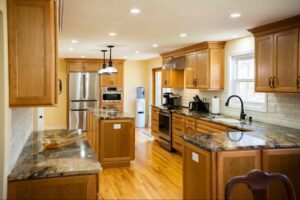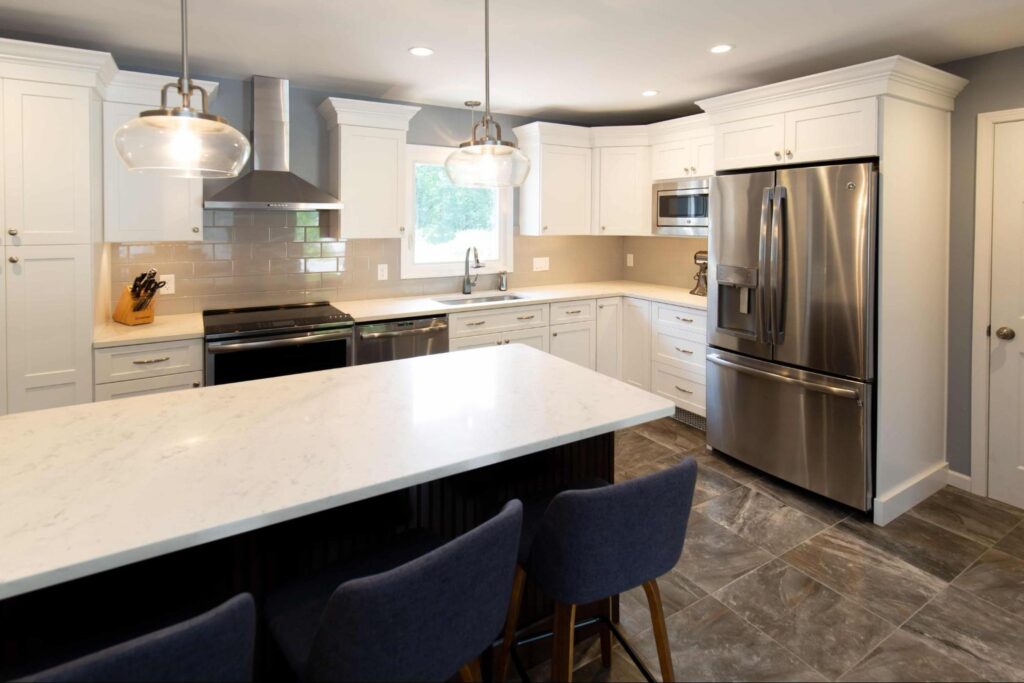If you’re reading this, you’re already ahead of most. You know choosing kitchen countertops isn’t just about looks; it’s a significant investment that affects your day-to-day life. The right countertop material should match your cooking habits, maintenance preferences, and long-term plans.
At Distinctive Surfaces, we’ve helped hundreds of homeowners avoid common pitfalls, from buying slabs with hidden flaws to choosing natural stone that doesn’t fit their lifestyle. Let’s walk through the most frequent errors and how to sidestep them, before they cost you.
What Are the 5 Most Common Mistakes Homeowners Make When Choosing Kitchen Countertops?
Why countertop selection often goes wrong — and how to avoid it

1. Choosing Based Solely on Looks
It’s easy to fall in love with a surface in the showroom; the color, the veining, the polish under perfect lighting. But the truth is, some countertop materials are more form than function.
That matte marble may look amazing on Instagram, but in a real kitchen, it can etch, stain, or scratch easily. A pure white quartz may look seamless until the kids spill grape juice or you leave a hot pan a little too long.
Your countertop is a significant investment, and it needs to work for your lifestyle, not just your design board.
2. Overlooking Maintenance Requirements
One of the most frequent errors homeowners make is assuming all countertops are low-maintenance by default.
Natural stones like granite and marble may require periodic sealing and special cleaners. Quartz countertops are more forgiving, but they’re not bulletproof; some still discolor under high heat or UV exposure.
Without considering maintenance, it’s easy to pick a material that becomes a chore. The reality: what you choose will need care. Skipping that conversation upfront leads to regrets later.
3. Ignoring Edge Profiles and Thickness
Edge profiles aren’t just a design detail; they affect safety, cleanability, and chip resistance.
- Rounded edges help prevent injuries in households with kids.
- Straight or mitered edges look modern but chip more easily on thinner slabs.
- Thinner countertops (2cm) may require laminated edges that are more prone to wear.
- Thicker countertops provide both visual weight and durability over time.
Many homeowners focus on the slab and overlook these details, only to wish they’d chosen differently after installation.
4. Failing to Match the Surface to the Way You Actually Live
Pinterest doesn’t know if you cook five nights a week. Or if you have toddlers. Or if you’re remodeling a rental.
Many homeowners choose based on aesthetics alone, and forget to ask: How will this surface hold up in my real life?
- If it stains easily, will I be OK with that?
- If it needs sealing, will I actually do it?
- If it’s light-colored, will I constantly be cleaning it?
Your kitchen countertop has to meet your life where it is—not where the design trends say it should be.
What to Think About Before You Choose a Kitchen Countertop
Avoiding these common pitfalls starts with asking the right questions

Most countertop regrets don’t come from lack of effort; they come from asking the wrong questions at the wrong time. Before you finalize your slab, your style, or your installer, take a step back and think through the bigger picture. These are the questions that separate a good kitchen from one that really works.
Are You Thinking About the Whole Kitchen — or Just the Countertops?
A countertop decision doesn’t happen in isolation. It shapes, and is shaped by, every other choice in your space.
Your selection will affect:
- Cabinet height and spacing
- Sink and faucet compatibility
- Edge profile clearance near appliances
- How colors and materials flow together
We’ve seen many homeowners fall in love with a slab, only to realize it clashes with the cabinet finish or doesn’t fit their existing layout. Choosing a slab without considering your full kitchen design can throw off the entire plan.
Are You Choosing Based on Budget — or Value?
It’s smart to set a budget. But it’s a mistake to chase the cheapest quote without digging into what’s included.
Low bids often mean:
- Lower-grade stone with more resin or defects
- Inexperienced fabricators
- Shortcuts during templating or installation that you’ll notice later
A countertop is a significant investment—it should be done once and done right.
Real value means:
- Durability you can rely on
- Precision work that fits your space perfectly
- A surface that performs for years, not just months
Don’t let short-term savings turn into long-term frustration.
Have You Seen the Actual Slab?
A 4×4 showroom sample can’t tell the whole story.
Color and veining vary, especially in natural stone like granite and marble. Even quartz, which is engineered for consistency, can have shifts in pigment or pattern placement that impact your kitchen’s look.
If possible, see the full slab before making your choice. Bring a cabinet finish sample and lighting reference, so you know exactly how everything will look together in your space, not just under showroom lighting.
This one step can prevent one of the most common mistakes homeowners make: buying a surface that looks totally different once installed.
Ready to Avoid the Usual Countertop Mistakes?
Schedule a No-Pressure Consultation
We’ve seen the most common pitfalls, materials that stain too easily, seams that don’t line up, and edges that chip in year one. You don’t need to learn those lessons the hard way.
Whether you’re considering granite, quartz, marble, or something fully custom, we’ll guide you through the process with real answers and honest advice, no upselling, no pressure.
Get it done right the first time.
FAQs About Countertop Selection Mistakes
What’s the #1 mistake homeowners make when selecting kitchen countertops?
Focusing only on appearance. The countertop may look perfect in the showroom, but if it can’t handle heat, spills, or daily wear in a real kitchen, it won’t hold up. Function and durability should always come first.
Are natural stones like granite and marble a bad choice?
Not at all. Granite and marble are beautiful, long-lasting materials, but they do require more upkeep than many homeowners expect. Understanding the maintenance needs and trade-offs up front is key to making the right decision for your space.
Can I trust the samples I see in a showroom?
Showroom samples are a good start, but they’re just that—a start. Full slabs often have more variation than the small piece you’re shown. Always ask to see the actual slab or a larger cut if you can.
Is quartz always better than granite?
Not necessarily. Quartz is more uniform and generally lower maintenance, which appeals to many homeowners. But granite offers natural variation and a unique look that can’t be replicated. The better option depends on your lifestyle and priorities.
What if I love a material but it’s not right for my lifestyle?
You’re not out of options. There are often alternative materials or finishes that offer a similar look with better performance. A good fabricator will guide you to a surface that fits both your style and your day-to-day needs.

